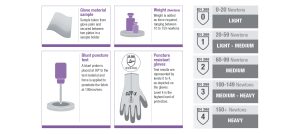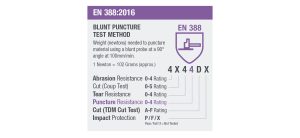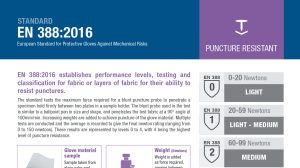STANDARD
EN 388:2016
European Standard for Protective Gloves Against Mechanical Risks

EN 388:2016 establishes performance levels, testing and classification for fabric or layers of fabric for their ability to resist punctures.
The standard tests the maximum force required for a blunt puncture probe to penetrate a specimen held firmly between two plates in a sample holder. The blunt probe used in the test is similar to a ballpoint pen in size and shape, and penetrates the test fabric at a 90° angle at 100mm/min. Increasing weights are added to achieve puncture of the glove material. Multiple tests are conducted and the average is recorded to give the final newton rating (ranging from 0 to 150 newtons). These results are represented by levels 0 to 4, with 4 being the highest level of puncture resistance.

Not all puncture resistant gloves protect against needlestick punctures.When working with hypodermic needles and other fine objects, choose a glove tested to the ASTM F2878 standard for resistance to needle puncture.

For the latest safety standards, classifications, testing criteria and ratings information, please refer to the appropriate governing body or association. Information contained in this document is subject to change without notice. As BDG® cannot control or anticipate the conditions under which a product may be used, each user should review the information in specific context of the planned use. To the maximum extent permitted by law, Bob Dale Gloves and Imports Ltd., and/or its affiliates, employees or representatives will not be responsible for damages of any nature resulting from the use or reliance upon the information contained in this sheet. No express or implied warranties are given other than those implied mandatory by law. BDG® products are not cut and puncture proof. Do not use with moving blades, tools or serrated blades.
